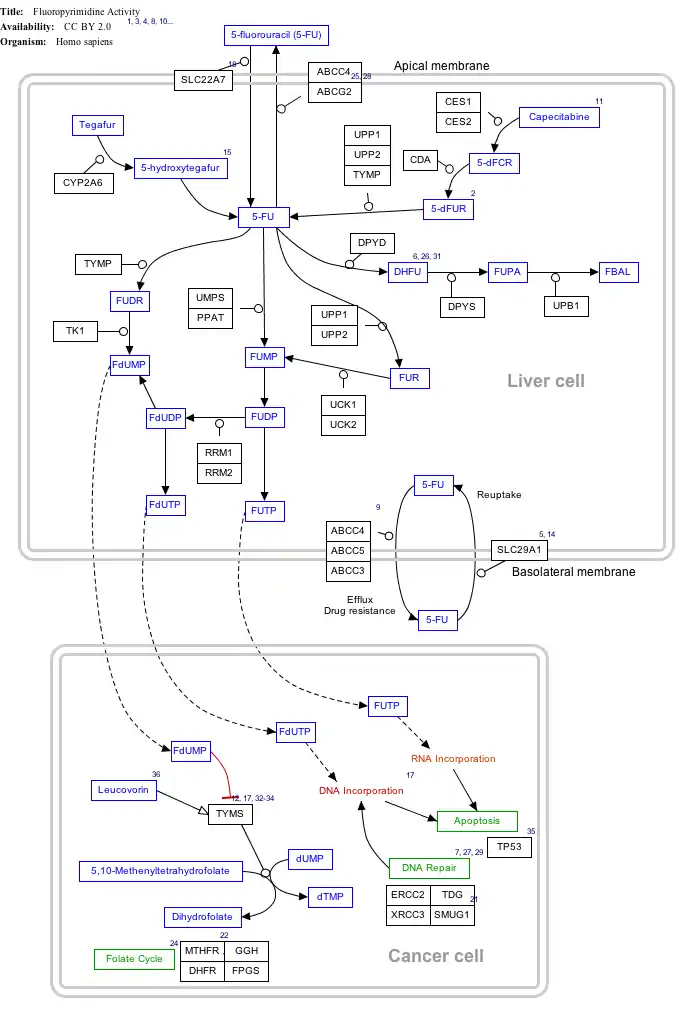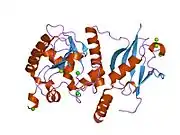G/T mismatch-specific thymine DNA glycosylase is an enzyme that in humans is encoded by the TDG gene.[4][5][6] Several bacterial proteins have strong sequence homology with this protein.[7]
Function
The protein encoded by this gene belongs to the TDG/mug DNA glycosylase family. Thymine-DNA glycosylase (TDG) removes thymine moieties from G/T mismatches by hydrolyzing the carbon-nitrogen bond between the sugar-phosphate backbone of DNA and the mispaired thymine. With lower activity, this enzyme also removes thymine from C/T and T/T mispairings. TDG can also remove uracil and 5-bromouracil from mispairings with guanine. TDG knockout mouse models showed no increase in mispairing frequency suggesting that other enzymes, like the functional homologue MBD4, may provide functional redundancy. This gene may have a pseudogene in the p arm of chromosome 12.[6]
Additionally, in 2011, the human thymine DNA glycosylase (hTDG) was reported to efficiently excise 5-formylcytosine (5fC) and 5-carboxylcytosine (5caC), the key oxidation products of 5-methylcytosine in genomic DNA.[8] Later on, the crystal structure of the hTDG catalytic domain in complex with duplex DNA containing 5caC was published, which supports the role of TDG in mammalian 5-methylcytosine demethylation.[9]
Interactions
Thymine-DNA glycosylase has been shown to interact with:
Interactive pathway map
Click on genes, proteins and metabolites below to link to respective articles.[§ 1]
- ↑ The interactive pathway map can be edited at WikiPathways: "FluoropyrimidineActivity_WP1601".
References
- 1 2 3 GRCh38: Ensembl release 89: ENSG00000139372 - Ensembl, May 2017
- ↑ "Human PubMed Reference:". National Center for Biotechnology Information, U.S. National Library of Medicine.
- ↑ "Mouse PubMed Reference:". National Center for Biotechnology Information, U.S. National Library of Medicine.
- ↑ Neddermann P, Gallinari P, Lettieri T, Schmid D, Truong O, Hsuan JJ, Wiebauer K, Jiricny J (August 1996). "Cloning and expression of human G/T mismatch-specific thymine-DNA glycosylase". J Biol Chem. 271 (22): 12767–74. doi:10.1074/jbc.271.22.12767. PMID 8662714.
- ↑ Sard L, Tornielli S, Gallinari P, Minoletti F, Jiricny J, Lettieri T, Pierotti MA, Sozzi G, Radice P (December 1997). "Chromosomal localizations and molecular analysis of TDG gene-related sequences". Genomics. 44 (2): 222–6. doi:10.1006/geno.1997.4843. PMID 9299239.
- 1 2 "Entrez Gene: TDG thymine-DNA glycosylase".
- ↑ Gallinari P, Jiricny J (October 1996). "A new class of uracil-DNA glycosylases related to human thymine-DNA glycosylase". Nature. 383 (6602): 735–8. Bibcode:1996Natur.383..735G. doi:10.1038/383735a0. PMID 8878487. S2CID 4235485.
- ↑ He YF, Li BZ, Li Z, Liu P, Wang Y, Tang Q, Ding J, Jia Y, Chen Z, Li L, Sun Y, Li X, Dai Q, Song CX, Zhang K, He C, Xu GL (September 2011). "Tet-mediated formation of 5-carboxylcytosine and its excision by TDG in mammalian DNA". Science. 333 (6047): 1303–7. Bibcode:2011Sci...333.1303H. doi:10.1126/science.1210944. PMC 3462231. PMID 21817016.
- ↑ Zhang L, Lu X, Lu J, Liang H, Dai Q, Xu GL, Luo C, Jiang H, He C (February 2012). "Thymine DNA glycosylase specifically recognizes 5-carboxylcytosine-modified DNA". Nature Chemical Biology. 8 (4): 328–30. doi:10.1038/nchembio.914. PMC 3307914. PMID 22327402.
- ↑ Tini M, Benecke A, Um SJ, Torchia J, Evans RM, Chambon P (February 2002). "Association of CBP/p300 acetylase and thymine DNA glycosylase links DNA repair and transcription". Mol. Cell. 9 (2): 265–77. doi:10.1016/S1097-2765(02)00453-7. PMID 11864601.
- ↑ Chen D, Lucey MJ, Phoenix F, Lopez-Garcia J, Hart SM, Losson R, Buluwela L, Coombes RC, Chambon P, Schär P, Ali S (October 2003). "T:G mismatch-specific thymine-DNA glycosylase potentiates transcription of estrogen-regulated genes through direct interaction with estrogen receptor alpha". J. Biol. Chem. 278 (40): 38586–92. doi:10.1074/jbc.M304286200. PMID 12874288.
- ↑ Takahashi H, Hatakeyama S, Saitoh H, Nakayama KI (February 2005). "Noncovalent SUMO-1 binding activity of thymine DNA glycosylase (TDG) is required for its SUMO-1 modification and colocalization with the promyelocytic leukemia protein". J. Biol. Chem. 280 (7): 5611–21. doi:10.1074/jbc.M408130200. PMID 15569683.
- 1 2 Hardeland U, Steinacher R, Jiricny J, Schär P (March 2002). "Modification of the human thymine-DNA glycosylase by ubiquitin-like proteins facilitates enzymatic turnover". EMBO J. 21 (6): 1456–64. doi:10.1093/emboj/21.6.1456. PMC 125358. PMID 11889051.
- ↑ Minty A, Dumont X, Kaghad M, Caput D (November 2000). "Covalent modification of p73alpha by SUMO-1. Two-hybrid screening with p73 identifies novel SUMO-1-interacting proteins and a SUMO-1 interaction motif". J. Biol. Chem. 275 (46): 36316–23. doi:10.1074/jbc.M004293200. PMID 10961991.
Further reading
- Lindahl T (1982). "DNA repair enzymes". Annu. Rev. Biochem. 51: 61–87. doi:10.1146/annurev.bi.51.070182.000425. PMID 6287922.
- Hardeland U, Bentele M, Lettieri T, et al. (2001). "Thymine DNA glycosylase". Base Excision Repair. Progress in Nucleic Acid Research and Molecular Biology. Vol. 68. pp. 235–53. doi:10.1016/S0079-6603(01)68103-0. ISBN 978-0-12-540068-8. PMID 11554300.
{{cite book}}:|journal=ignored (help) - Chevray PM, Nathans D (1992). "Protein interaction cloning in yeast: identification of mammalian proteins that react with the leucine zipper of Jun". Proc. Natl. Acad. Sci. U.S.A. 89 (13): 5789–93. Bibcode:1992PNAS...89.5789C. doi:10.1073/pnas.89.13.5789. PMC 402103. PMID 1631061.
- Neddermann P, Jiricny J (1994). "Efficient removal of uracil from G.U mispairs by the mismatch-specific thymine DNA glycosylase from HeLa cells". Proc. Natl. Acad. Sci. U.S.A. 91 (5): 1642–6. doi:10.1073/pnas.91.5.1642. PMC 43219. PMID 8127859.
- Neddermann P, Jiricny J (1993). "The purification of a mismatch-specific thymine-DNA glycosylase from HeLa cells". J. Biol. Chem. 268 (28): 21218–24. doi:10.1016/S0021-9258(19)36913-3. PMID 8407958.
- Barrett TE, Savva R, Panayotou G, et al. (1998). "Crystal structure of a G:T/U mismatch-specific DNA glycosylase: mismatch recognition by complementary-strand interactions". Cell. 92 (1): 117–29. doi:10.1016/S0092-8674(00)80904-6. PMID 9489705. S2CID 9136303.
- Missero C, Pirro MT, Simeone S, et al. (2001). "The DNA glycosylase T:G mismatch-specific thymine DNA glycosylase represses thyroid transcription factor-1-activated transcription". J. Biol. Chem. 276 (36): 33569–75. doi:10.1074/jbc.M104963200. PMID 11438542.
- Tini M, Benecke A, Um SJ, et al. (2002). "Association of CBP/p300 acetylase and thymine DNA glycosylase links DNA repair and transcription". Mol. Cell. 9 (2): 265–77. doi:10.1016/S1097-2765(02)00453-7. PMID 11864601.
- Hardeland U, Steinacher R, Jiricny J, Schär P (2002). "Modification of the human thymine-DNA glycosylase by ubiquitin-like proteins facilitates enzymatic turnover". EMBO J. 21 (6): 1456–64. doi:10.1093/emboj/21.6.1456. PMC 125358. PMID 11889051.
- Strausberg RL, Feingold EA, Grouse LH, et al. (2003). "Generation and initial analysis of more than 15,000 full-length human and mouse cDNA sequences". Proc. Natl. Acad. Sci. U.S.A. 99 (26): 16899–903. Bibcode:2002PNAS...9916899M. doi:10.1073/pnas.242603899. PMC 139241. PMID 12477932.
- Abu M, Waters TR (2003). "The main role of human thymine-DNA glycosylase is removal of thymine produced by deamination of 5-methylcytosine and not removal of ethenocytosine". J. Biol. Chem. 278 (10): 8739–44. doi:10.1074/jbc.M211084200. PMID 12493755.
- Shimizu Y, Iwai S, Hanaoka F, Sugasawa K (2003). "Xeroderma pigmentosum group C protein interacts physically and functionally with thymine DNA glycosylase". EMBO J. 22 (1): 164–73. doi:10.1093/emboj/cdg016. PMC 140069. PMID 12505994.
- Chen D, Lucey MJ, Phoenix F, et al. (2003). "T:G mismatch-specific thymine-DNA glycosylase potentiates transcription of estrogen-regulated genes through direct interaction with estrogen receptor alpha". J. Biol. Chem. 278 (40): 38586–92. doi:10.1074/jbc.M304286200. PMID 12874288.
- Lehner B, Semple JI, Brown SE, et al. (2004). "Analysis of a high-throughput yeast two-hybrid system and its use to predict the function of intracellular proteins encoded within the human MHC class III region". Genomics. 83 (1): 153–67. doi:10.1016/S0888-7543(03)00235-0. PMID 14667819.
- Brandenberger R, Wei H, Zhang S, et al. (2005). "Transcriptome characterization elucidates signaling networks that control human ES cell growth and differentiation". Nat. Biotechnol. 22 (6): 707–16. doi:10.1038/nbt971. PMID 15146197. S2CID 27764390.
- Krześniak M, Butkiewicz D, Samojedny A, et al. (2005). "Polymorphisms in TDG and MGMT genes - epidemiological and functional study in lung cancer patients from Poland". Ann. Hum. Genet. 68 (Pt 4): 300–12. doi:10.1046/j.1529-8817.2004.00079.x. PMID 15225156. S2CID 35293833.
- He YF, Li BZ, Li Z, Liu P, Wang Y, Tang Q, Ding J, Jia Y, Chen Z, Li L, Sun Y, Li X, Dai Q, Song CX, Zhang K, He C, Xu GL (September 2011). "Tet-mediated formation of 5-carboxylcytosine and its excision by TDG in mammalian DNA". Science. 333 (6047): 1303–7. Bibcode:2011Sci...333.1303H. doi:10.1126/science.1210944. PMC 3462231. PMID 21817016.
- Zhang L, Lu X, Lu J, Liang H, Dai Q, Xu GL, Luo C, Jiang H, He C (February 2012). "Thymine DNA glycosylase specifically recognizes 5-carboxylcytosine-modified DNA". Nature Chemical Biology. 8 (4): 328–30. doi:10.1038/nchembio.914. PMC 3307914. PMID 22327402.
- Xu J, Cortellino S, Tricarico R, Chang WC, Scher G, Devarajan K, Slifker M, Moore R, Bassi MR, Caretti E, Clapper M, Cooper H, Bellacosa A (September 2017). "Thymine DNA Glycosylase (TDG) is involved in the pathogenesis of intestinal tumors with reduced APC expression". Oncotarget. 8 (52): 89988–89997. doi:10.18632/oncotarget.21219. PMC 5685726. PMID 29163805.






